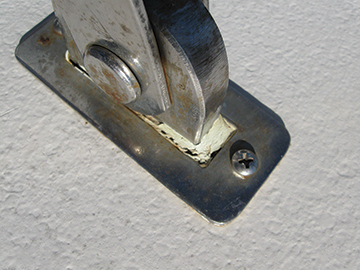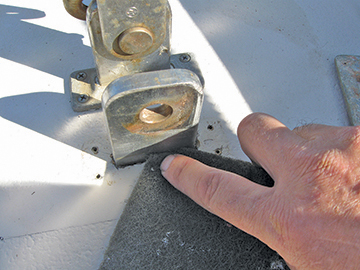Regularly inspect your chainplates to avoid an unexpected failure (published August 2013)
Servicing chainplates is not an item you often find on a sailboat owners list of maintenance tasks because many never think their chainplates need it. For the most part, they would be right, but like it or not, chainplates do need some care. The failure of a chainplate can be catastrophic and is one of the leading causes of dismasting on older boats.
Every boat owner knows that anything penetrating the deck is a potential source of a leak. And due to the movement caused by stress on the rigging, this is particularly true with chainplates. Leaks into and through the deck from around the chainplates can cause water damage to the deck and cabinetry. So performing a periodic inspection of these leak-prone areas will give you piece of mind and prevent any future problems.
TYPES OF CORROSION AND CHAINPLATES
The biggest enemy of chainplates is corrosion. Although most chainplates are made of stainless steel, this does not mean they are immune to corrosion. The two most common types of corrosion that lead to failure are pit or crevice corrosion and stress corrosion. Stainless steel gains a good part of its corrosion resistance from a surface film that forms when the metal is exposed to oxygen. This causes a problem for chainplates that are installed through the deck. When a chainplate passes through the deck it is blocked from oxygen by sealants, trim plates and contact with the deck. Any moisture that gets into this area can cause corrosion, as small pits will form on the surface and begin to eat into the metal. Additionally, cycling loads placed on the chainplates can cause stress corrosion. Stress corrosion is a type of corrosion that results in hairline cracks that can lead to sudden failure.
Because of all this corrosion, you might think that stainless steel would not be a good metal for chainplates. As with most things on boats though, stainless steel is a compromise between strength and cost. There may be better metals out there, but for the cost, stainless is not a bad concession to make. With the appropriate care and a bit of attention to the problem areas, all types of stainless steel chainplates will provide many years of good service.
The most common type of chainplate is a flat bar that is bolted to an interior bulkhead or knee and then passes through the deck where a metal trim plate is fitted. Even though this setup is the most common, it is also one of the most prone to leaking. Another common type of chainplate is one that is welded to a flat plate that sits flush on the deck. The underside of this plate is then attached to a rod or bolt that passes through the deck to be attached to a structural member inside the boat.
Although most chainplates are bolted to structural members inside the boat, some are glassed in. Glassed in chainplates are by far the worst to inspect or replace and the fiberglass will trap any moisture in and around the metal. Also, fiberglass does not adhere well to metal, making voids between the fiberglass and chainplate inevitable.
VISUAL INSPECTION
Owners should inspect their chainplates annually and I recommend that the chainplates be pulled for a more thorough inspection once every 5 years after the boat is more than ten years old. No matter how your chainplates are installed, the first place to start is with a visual inspection of the outside. Carefully inspect around clevis pins and bolt holes for cracks or any deformities. I like to use a magnifying glass to aid with this and will use a small piece of Scotch Brite pad to clean the metal where needed. Look carefully for hairline cracks and for rust stains at holes and welds. Surface rust stains can be a tell tale sign of worse corrosion. If you are inspecting chainplates that are bolted to the exterior of the hull, check the bolts for rust staining as well.
Next, go inside the boat and remove any panels needed to gain access to the underside of the chainplates. If it is difficult to see the chainplates without major disassembly try looking below and around them for signs of leakage, rust stains or water damage to the woodwork. Any sign of water or rust will require further investigation. Don’t forget to check the forestay and backstay chainplates as well. Forestays and backstays are often bolted onto the outside of the hull, but you still need to look inside at the bolts and backing plates.
By far the most common failure point for chainplates is where they pass through the deck. This is true for most types of chainplates with the exception of forestay chainplates. Forestay chainplates will most often fail at a weld or where the metal is bent around the stem head. They can also be damaged from impacts with docks and other objects and are subject to side loading from the rig. Additionally, any chainplate that passes through wood decking or cap rails should be carefully checked. The wood surrounding the chainplate will always contain some moisture and if there are any leaks, the wood will hold the moisture longer causing them to be more susceptible to corrosion.

Chainplates that have a rod attached on the underside and are then attached to the hull need some special attention, as there are usually toggles or turnbuckles fitted to the rod. Check that all fittings and fasteners are tight and secure. Any leaks will often run down the rod causing corrosion at the ends of the fittings. The rods and fittings need to be carefully inspected for corrosion, cracking and elongation. Check the hull attachment members as well. If glassed in, look for any signs of delamination or cracking in the fiberglass. Also, a moisture meter can be helpful for checking structural members made of glass over wood.

If everything looks good and there are no signs of water leakage around the chainplates and you have not noticed any cracks, rust stains or other anomalies then you are likely good to go. If, however, you see any sign of trouble it is time to get more serious. If you note any cracks in the metal or elongated holes it is time to start thinking about completely removing the chainplates for more careful inspection or replacement. If you are seeing signs of water leakage or rusting you may just need to reseal the chainplates, but before you can know for sure, further investigation is required.

CHAINPLATE REMOVAL
All types of chainplates can suffer from pit and or crevice corrosion where the fitting passes through the deck and often removal is the only way to inspect for problems. Although some chainplates can be very hard to remove it is often the only way to ensure they are in good condition. In many cases it is not as hard as it looks. For most boats this task can be completed in a weekend. If access is poor you may be able to add removable panels to make the job easier.

Once the chainplates have been removed it is time to clean them up for inspection. Carefully remove all sealant that may be stuck to them. Solvent may help with this as well as some light scraping. Then use a medium Scotch Brite pad to polish any rust or stains from the surface. After cleaning, visually inspect them for any pitting or cracks. If you see lines that you are not sure about, using a dye penetrate will aid in determining if it is a surface defect or crack. Check for surface pitting as well. Small pits will easily develop into deeper pits that will weaken the metal. If there is any doubt about the integrity of a chainplate, replacement is always the safest option.

With your chainplates fully disassembled make sure to carefully inspect the fasteners that secure them to the boat. And unless cost or availability is a factor, it is a good idea to think about replacing these bolts. Also, check the bolt holes in both the chainplate and boat as well. If they are not a snug fit, it would be wise to drill wider holes and install larger bolts or bushings to remove any play.
While chainplate inspection may not be a top priority, it is a prudent thing to add to your list of annual maintenance tasks. Completing such an inspection will provide you with piece of mind and help protect you and your boat from injury or catastrophic damage.
Capt. Wayne Canning lives aboard his Irwin 40, VAYU, in Wilmington NC. He is a full-time marine surveyor, delivery skipper and consultant/project manager on major boat repairs. Capt. Wayne also runs websites for other marine professionals, and those restoring project boats. For more information visit www.4ABetterBoat.com or www.projectboat.info.















